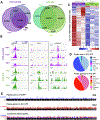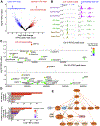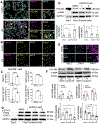Integrated multiomic analysis identifies TRIP13 as a mediator of alveolar epithelial type II cell dysfunction in idiopathic pulmonary fibrosis
- PMID: 39547519
- PMCID: PMC11951472
- DOI: 10.1016/j.bbadis.2024.167572
Integrated multiomic analysis identifies TRIP13 as a mediator of alveolar epithelial type II cell dysfunction in idiopathic pulmonary fibrosis
Abstract
Idiopathic pulmonary fibrosis (IPF) is a lethal progressive lung disease urgently needing new therapies. Current treatments only delay disease progression, leaving lung transplant as the sole remaining option. Recent studies support a model whereby IPF arises because alveolar epithelial type II (AT2) cells, which normally mediate distal lung regeneration, acquire airway and/or mesenchymal characteristics, preventing proper repair. Mechanisms driving this abnormal differentiation remain unclear. We performed integrated transcriptomic and epigenomic analysis of purified AT2 cells which revealed genome-wide alterations in IPF lungs. The most prominent epigenetic alteration was activation of an enhancer in thyroid receptor interactor 13 (TRIP13), although TRIP13 was not the most significantly transcriptionally upregulated gene. TRIP13 is broadly implicated in epithelial-mesenchymal plasticity. In cultured human AT2 cells and lung slices, small molecule TRIP13 inhibitor DCZ0415 prevented acquisition of the mesenchymal gene signature characteristic of IPF, suggesting TRIP13 inhibition as a potential therapeutic approach to fibrotic disease.
Keywords: ATAC-seq; Epigenomic analysis; Epithelial-mesenchymal plasticity; Idiopathic pulmonary fibrosis (IPF); RNA-seq; TRIP13.
Copyright © 2024. Published by Elsevier B.V.
Conflict of interest statement
Declaration of competing interest The authors declare that they have no known competing financial interests or personal relationships that could have appeared to influence the work reported in this paper.
Figures




References
-
- King TE, Pardo A, Selman M, Idiopathic pulmonary fibrosis, Lancet 378 (9807) (2011) 1949–1961. - PubMed
-
- Luo W, Gu Y, Fu S, Wang J, Zhang J, Wang Y, Emerging opportunities to treat idiopathic pulmonary fibrosis: design, discovery, and optimizations of small-molecule drugs targeting fibrogenic pathways, Eur. J. Med. Chem 260 (2023) 115762. - PubMed
-
- George PM, Patterson CM, Reed AK, Thillai M, Lung transplantation for idiopathic pulmonary fibrosis, Lancet Respir. Med 7 (3) (2019) 271–282. - PubMed
-
- Selvarajah B, Platé M, Chambers RC, Pulmonary fibrosis: emerging diagnostic and therapeutic strategies, Mol. Aspects Med 94 (2023) 101227. - PubMed
-
- Pauchet A, Chaussavoine A, Pairon JC, Gabillon C, Didier A, Baldi I, et al., Idiopathic pulmonary fibrosis: what do we know about the role of occupational and environmental determinants? A systematic literaturereview and meta-analysis, J. Toxicol. Environ. Health B Crit. Rev 25 (7) (2022) 372–392. - PubMed
Publication types
MeSH terms
Substances
Grants and funding
LinkOut - more resources
Full Text Sources
Molecular Biology Databases

